The Good (Not the Bad and the Ugly)
|
I would like credit for creating an exceptionally good tropical
waterlily – Nymphaea ‘Hickory Bend Ruth’
– but a bee flitting from flower to flower is probably responsible.
Ruth and I have raised hardy and tropical waterlilies for a couple
of decades. Before our hobby became a business, I tended to be
somewhat casual with plant identification. If a sprout of a tropical
waterlily seedling had red spots on the underside of the leaves,
I called it ‘Shirley Bryne’, our only one like that.
A few years ago, I noticed two or three lilies labeled ‘Shirley
Bryne’ displayed maroon streaks on the leaves, unlike any
other variety then in our collection. That difference saved them
from being composted along with the actual “Shirleys”
to make room for new tropical varieties.
When those unique-leaved plants bloomed, they produced distinctive
flowers as well. The very large, up to 8-inch (20-centimeter),
lovely lavender-pink blossoms sported pink-tipped, bright yellow
stamens. This alone guaranteed the new cultivar space in our
collection. It produced an abundance of flowers, often four or
five at a time. The pads became more beautiful with age, changing
from green with maroon streaks to chartreuse or even gold with
red streaks. Keeping flowers open until late afternoon provided
a welcome bonus.
Having won a place in our collection, the new variety needed
a name. I christened her ‘Hickory Bend Ruth’ in honor
of my lovely wife. The non-viviparous ‘Hickory Bend Ruth’
produces fertile seeds and quite a few tubers. Planted in a 5-quart
(4.7 liter) or larger container, “Ruth” covers a 5-foot
(1.5-meter) diameter area with 12-inch (30-centimeter) leaves.
However, she happily grows tub-garden size when planted in 4-inch
(10-centimeter) or 5-inch (13-centimeter) containers. Unfortunately,
her intense fragrance attracts Japanese beetles. You have to
remove them often or else they devour the flowers. |
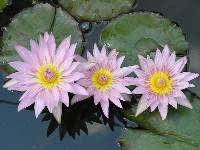
|
Since Nymphaea “Ruth” joined our collection,
we have watched for additional serendipitous arrivals and have
tried our hand at hybridizing. Although our hybridizing efforts
have produced nothing worthwhile, Mother Nature has created a
few intriguing hybrids. Last year we wintered over several “Ruth”
seedlings. Algae that we did not control well in outside tubs
claimed most of them this summer. |
|
Nevertheless, a few with leaves unlike “Ruth” survived
and bloomed. To our surprise, they stayed quite small, developed
viviparous leaves, and bloomed very similarly to ‘Daubenyana’.
Tentatively called ‘Itsy Bitsy Blue’, it grows much
smaller than ‘Daubenyana’ and its more uniformly blue
flowers contain fewer petals. I hope subsequent generations will
also produce extremely dwarf plants. If size of the viviparous
sprouts is any indication, this variety is what we seek. The
plantlets are so tiny that they are difficult to handle and they
easily succumb to algae. |
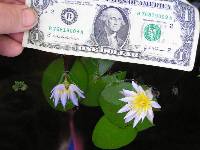 ^ Provisionally
^ Provisionally
N. 'Itsy Bitsy Blue' v
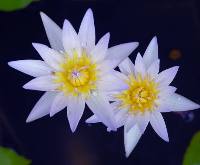 |
|
An earlier incident with what we had hoped would be an extremely
dwarf hardy white turned out to be simply a slow developer. That
event diminished our optimism. We have had plants that stayed
very small for a year or two before taking off. A "Pink
Chrysantha" purchased last spring remained small enough
to fit in a teacup until early fall. Even then it had a leaf
spread of less than 10 inches (25 centimeters) but, assuming
it is "Truly Named", I anticipate it will attain a
leaf spread well over 24 inches (61 centimeters) next year. If
'Itsy Bitsy Blue' does not turn out to be the extreme dwarf we
hope for, I will compost the plants. The world does not need
a 'Daubenyana' wannabe to contaminate the gene pool. |
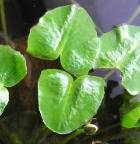
^ Provisionally
N. 'Hickory Bend Cupid' v
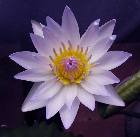 |
This year, while selecting tropical lilies to winter
in the greenhouse and sunroom, we noticed that a lily labeled
‘Paul Stetson’ had solid green leaves with sinuses
so wide open that the leaves were heart shaped. Ruth, my wife
not the lily, insisted that I bring it inside. It had probably
bloomed outside. However, not until the lily bloomed in the greenhouse
did we notice its flowers were purple tinted white. Being unlike
any other variety in our collection, we call it ‘Hickory
Bend Cupid’.
Its cup-shaped flowers open wide by the second or third day
and consistently open the forth day. “Cupid” blooms
very well in our sunroom with only a few hours of somewhat filtered
sunlight. The flowers open extremely early. I do not know if
it is due to the limited direct sunlight in our sunroom, but
“Cupid” flowers consistently greet me at dawn. We have
much to learn about “Cupid”. I will track it for several
years. Given its unique leaf shape and early-opening beautiful
flowers, I hope it will prove worth cultivating. |
|
If you have more than one waterlily variety, keep an eye out
for natural crosses. Even if you have only one hybrid variety,
remember that seedlings are unreliable and vary widely. Odds
are that natural crosses or F-something seedlings will not be
worth cultivating. However, with a bit of luck you might discover
something special. |
|
The Bad and the Ugly (Not the Good) |
|
When a chance seedling occurs, the nursery may unwittingly misidentify
and sell it under the seed parent’s name. Last spring I
bought a ‘Fabiola’ from Wal-Mart to see if the practically
rootless piece of tuber with dried up sprouts would actually
grow. To my amazement, it took off and was producing flowers
by late summer. Instead of presenting the pink, medium-sized
flowers I expected, it offered large blooms, starting out bright
pink and changing to snow white by the third day. As I can find
no similar cultivar, the plant might be a natural hybrid, unique
and very beautiful. I plan to track ‘Pink Blush’ for
a few years to see if it merits propagating. |

Provisionally N. 'Pink Blush' |
|
Too many other plants have failed to be the labeled variety.
Years ago, I purchased a plant labeled ‘Attraction’
that produced white flowers. The same thing happened with two
‘Black Opals’ I purchased online last year. I have
also received other mislabeled lilies including what looked like
‘Peaches and Cream’ instead of ‘Pink Sparkle’,
‘Pink Sensation’ instead of ‘Pink Sparkle’,
and a tropical colorata instead of a hardy ‘Colorado’.
The source responsible for the colorata-‘Colorado’
mix-up made the same mistake twice more with replacements even
though we ordered in writing using product code and proper name.
The point I make, based on personal experience, is that mislabeling
is common. Do not assume that a purchased or gift plant is properly
identified unless the leaves, flowers and stems conform to official
description and photographs. (See WGI
Checklist.)
The nursery involved in two of the mix-ups blamed their supplier
for the mistake -- a sign of the times. Deny responsibility;
blame someone else. As garden centers and nurseries switch from
raising their own plants to purchasing them from factory farms,
many of which depend on seasonal laborers, mislabeling is more
apt to occur.
Additionally, some sources sell varieties by the wrong name.
You may have noticed names such as “True Fabiola” or
“#1” and “#2" versions of the same variety
in books. According to Perry Slocum, some species, such as Nymphaea
micrantha, have crossed with other waterlilies so often that
pure specimens may only exist in the wild. For three years, I
have attempted to purchase true tetragonas, with tiny
white flowers that have 8 to 13 petals, mottled leaves and a
very small leaf spread as described by Slocum. What I have received
appear to be ‘Walter Pagels’ with many-petaled pink-tinted
flowers having a 30-inch (76-centimeter) spread of solid green
leaves and very similar plants with non-pink-tinted flowers.
I have given up the effort. |
|
I write this based on my own personal experience to convey
three points:
One, assuming there is more than one variety of waterlily
in an area, potential exists for natural crosses, some of which
may be worth propagating.
Two, carefully avoid seedlings from a hybrid variety labeled
as a recognized variety (as evidently happened with the so-called
‘Fabiola’ from Wal-Mart). Since what seemed to be a
floating chance-seedling was mistaken for an ‘Islamorada’,
I label only viviparous plantlets identified while still attached
to a leaf firmly attached to a known variety. While I may investigate
a few intriguing free-floating plantlets or seedlings, I make
no pretense of knowing their family tree. To reduce the possibility
of propagating a chance seedling as a known variety, I divide
only plants whose flowers conform to the description of said
variety. I never use unconnected sprouts that might be seedlings.
Three, never assume that a purchased or gift waterlily is
properly identified unless the leaves, flowers and stems are
as anticipated. Flower color varies, but should come reasonably
close to descriptions. Photographs of flowers help a lot, but
colors shown can be misleading. Blue flowers can appear pink
or nearly white. The color value of flowers shown in online catalogs
and photo galleries vary from monitor to monitor. It is impossible
to depict some colors on a printed page or on line. Colors that
fluoresce, such as the fluorescent rose pink of ‘Mayla’
flowers, are impossible to achieve. Given the differing opinions,
I have virtually given up using authors’ leaf-spreads as
a guide for validating identity. The Encyclopedia of Water Garden
Plants by Greg and Sue Speichert, for instance, says that ‘Chromatella’
has a 6 to 12 foot (1.8 to 3.7 meter) leaf spread while Water
Lilies and Lotuses by Perry Slocum says the leaf spread is 3
feet (0.9 meter). Both books agree that ‘Peace Lily’
makes a 3 to 5 foot (0.9 to 1.5 meter) leaf spread and 3 to 5
inch (8 to 13 centimeter) flowers. Mine, however, that produce
6 foot (1.8 meter) leaf spreads and huge 8 inch (20 centimeter)
flowers, evidently did not read the books.
With distribution of waterlily cultivators comes responsibility.
Selling or giving away a lily of questionable origin as a known
variety is like offering the pups of the chance mating of a purebred
bitch that ran free at the wrong time as purebred. Carrying the
comparison one step further, even if one or more of the pups
from a chance mating looks like the mother, it is not a purebred
and will produce mongrel pups. The following warning given on
the Victoria Seed Request Form holds true for all hybrids:
If you cross a primary hybrid “with itself or other hybrids,
it produces what are called F2 seeds. These are highly variable
in their characteristics and unreliable. There is a danger that
they will be mistaken for the real F1 hybrid or even the species
after several generations. Not only may they be disappointing
to the grower, but they also could make their way into breeding
programs and corrupt the gene pool.”
I could not say it better.
Editor’s note: Aquatic nursery owner
Charles Leach sent us this potent message about the adverse connection
between waterlily seedlings and waterlily misidentification.
As more growers and retailers join the WGI Truly
Named program and waterlily buyers limit their purchases
to Truly
Named plants, the heyday of waterlily identity theft can
be relegated to the past. |
|
I took an early retirement due to the globalization of the
screen printing industry that I helped build. Prior to that I
wrote quite a few technical articles for the Screen Printing
Association. Since retirement this is my first attempt to write
anything except a few nasty letters to politicians .
Given a choice of becoming a greeter at Wal-Mart, moving to
China or getting involved in water gardening full time, I chose
the last. Since then I have been digging pools and hauling dirt
by hand instead of sitting behind a desk, in a car or on a plane,
and the  results
are positive. My weight is down 40 pounds, my blood pressure
is down 30 points and my mood has been anything but down. I'm
doing something I love, with someone I love, and am pretty sure
that water gardening will survive in this country and not be
moved entirely to Asia. results
are positive. My weight is down 40 pounds, my blood pressure
is down 30 points and my mood has been anything but down. I'm
doing something I love, with someone I love, and am pretty sure
that water gardening will survive in this country and not be
moved entirely to Asia.
Charles Leach
Hickory Bend Water Gardens & More
Lynchburg, Ohio |
Truly Named WGI ©
|







